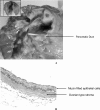Genetic and epigenetic alterations in pancreatic carcinogenesis
- PMID: 21886451
- PMCID: PMC3129039
- DOI: 10.2174/138920211794520132
Genetic and epigenetic alterations in pancreatic carcinogenesis
Abstract
Pancreatic ductal adenocarcinoma (PDAC) is one of the most lethal cancers worldwide. Despite significant progresses in the last decades, the origin of this cancer remains unclear and no efficient therapy exists. PDAC does not arise de novo: three remarkable different types of pancreatic lesions can evolve towards pancreatic cancer. These precursor lesions include: Pancreatic intraepithelial neoplasia (PanIN) that are microscopic lesions of the pancreas, Intraductal Papillary Mucinous Neoplasms (IPMN) and Mucinous Cystic Neoplasms (MCN) that are both macroscopic lesions. However, the cellular origin of these lesions is still a matter of debate. Classically, neoplasm initiation or progression is driven by several genetic and epigenetic alterations. The aim of this review is to assemble the current information on genetic mutations and epigenetic disorders that affect genes during pancreatic carcinogenesis. We will further discuss the interest of the genetic and epigenetic alterations for the diagnosis and prognosis of PDAC. Large genetic alterations (chromosomal deletion/amplification) and single point mutations are well described for carcinogenesis inducers. Mutations classically occur within key regions of the genome. Consequences are various and include activation of mitogenic pathways or silencing of apoptotic processes. Alterations of K-RAS, P16 and DPC4 genes are frequently observed in PDAC samples and have been described to arise gradually during carcinogenesis. DNA methylation is an epigenetic process involved in imprinting and X chromosome inactivation. Alteration of DNA methylation patterns leads to deregulation of gene expression, in the absence of mutation. Both genetic and epigenetic events influence genes and non-coding RNA expression, with dramatic effects on proliferation, survival and invasion. Besides improvement in our fundamental understanding of PDAC development, highlighting the molecular alterations that occur in pancreatic carcinogenesis could provide new clinical tools for early diagnosis of PDAC and the molecular basis for the development of new effective therapies.
Keywords: Cancer; DNA methylation; Genetic alteration.; Pancreas; Preneoplastic lesions.
Figures



References
-
- Jemal A, Siegel R, Ward E, Hao Y, Xu J, Thun M J. Cancer statistics, 2009. CA Cancer J. Clin. 2009;59:225–249. - PubMed
-
- Brat D J, Lillemoe K D, Yeo C J, Warfield P B, Hruban R H. Progression of pancreatic intraductal neoplasias to infiltrating adenocarcinoma of the pancreas. Am. J. Surg. Pathol. 1998;22:163–169. - PubMed
LinkOut - more resources
Full Text Sources
Other Literature Sources
Medical
Miscellaneous
